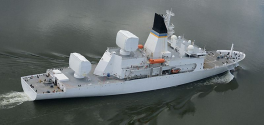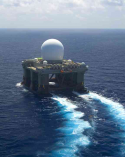Type 346 radar was developed during the 1990s where the program for a "Chinese Divine Shield/ 中华神盾" aka first the program of 海之星 was started in the late 1980s and then the Type 346 onboard Type 052C was completed put into service around the turn of the century - officially introduced in early 2000s but by then all the 346 programs were completed and well past trials.
The 346/ 中华神盾 has taken over a decade from conception to service. Lots of changes, programs, new technologies. It made use of AESA in fact it is the first major ship based search radar and fire control radar that used AESA. This series was also the first to make use of dual bands. Came out before the Sampson and well before the IAI's EL/M 2248 aka MF-Star.
Point is China was never that backward in radar technology. Certainly back in the 1980s was behind but not backwards. After all China developed all types of radars since the 1950s, even major phased arrays for early warning back in the 1950s.
I would probably characterize the level of Chinese radar technology somewhat differently. You're right about China has had quite a long history of developing large scale radar and was not as far behind the US/West as, say various engine technologies. But there are different types of radars, from large land-based radar, ship-based radar, to aircraft radar, with increasing challenges in that order. USSR/Russia also had a very long history in radar, but Russia today still struggles to develop AESA for its fighter aircraft.
A couple of tidbit stories may help illustrate the level and development of Chinese radar technologies, particularly AESA radars.
A lot of people are probably aware of the story of the development of Type 346 for 052C in the '90s, which was told by one of the lead engineers working on the project at the time who later immigrated to Canada. So China started developing ship-based AESA back in the 1990s.
In the early 2000s, China had contracted Israel to equip Israelis AESA-based system on its first batch of AWACS aircraft (IL-76). Israel canceled the project later under US pressure. The Chinese later said that although they did not get the radar from the Israelis but they did learn from Israelis to do quality control on mass production of the modules. I suppose this tells us that Chinese experiences before were mostly limited to large radars with limited quantity. Mass production of the modules with consistent quality was a challenge they learned to overcome later. So China successfully developed the aircraft-based early warning AESA radar in the 2000s.
Finally, when the Project 718 (J-20) was officially approved, it was said there were two potentially most critical barriers to success. One is obviously engine, the other radar. I remember reading comments from some key members of the CAC team that "it looked like AESA radar is no longer a concern" back when J-20 was still under active development. Cearly, China solved the fighter aircraft AESA problem in the early 2010s.
It's just that in the 1980s and 1990s Type 346 would be behind SPY-1 but made use of AESA which is superior to SPY-1 in that department (a generalisation in the technology base). Each iteration and new radar after simply was developed and completed faster and made larger leaps of technology compared to American counterparts where they are still using SPY-1 with PESA technology (even SPY-1D and latest SPY-1 radars except for the SPY-1E) and GaA today. SPY-6 is still in development or trials and hopes to reach the general tech levels of Type 346B with AESA and GaN. I doubt China would be behind the US at all in any other subsystems radar related, certainly with far superior communications technologies which fall into CEC and IFF domains.
China was never that behind the US in radars. Since Type 346B (and many other land, space, sea based radars) China has actually shown far greater radar capabilities. US has not got any real specialised counter stealth radars (sure they never thought they'd need them back in the 1990s since these take a while to develop and improve over time), early warning, phased radars are peers and have been since the turn of the century. China was allegedly able to jam and spoof Taiwan's new American Pave Paws type radar as soon as it became operational with what was suspected by Janes to be a EW large phased array based in Fujian, directed in an electronic attack on the American tech early warning radar in Taiwan.
The US is yet to put into service something equivalent to Type 346A which was completed and on PLAN service by 2012. Nevermind the Type 346B onboard the 055 destroyer - a ship that puts out more than twice as much power as a Maya class and nearly twice as much available power as a Burke Flight II. All that going into electromagnetic weapons and sensors... those 346B radars are pretty much weapons at this point.
I'd agree with you that Chinese radar technologies are largely on par with the US today.


